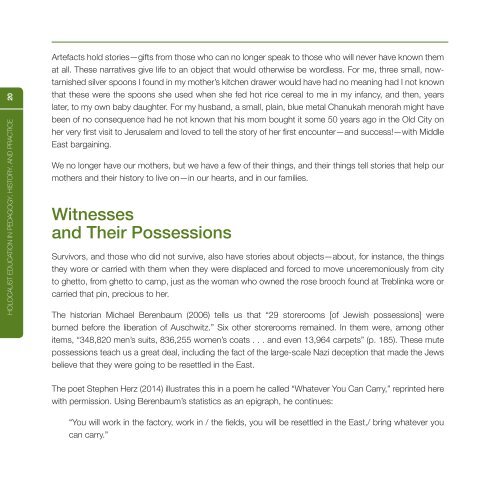2kNreeJ
2kNreeJ
2kNreeJ
You also want an ePaper? Increase the reach of your titles
YUMPU automatically turns print PDFs into web optimized ePapers that Google loves.
HOLOCAUST EDUCATION IN PEDAGOGY, HISTORY, AND PRACTICE 20<br />
Artefacts hold stories—gifts from those who can no longer speak to those who will never have known them<br />
at all. These narratives give life to an object that would otherwise be wordless. For me, three small, nowtarnished<br />
silver spoons I found in my mother’s kitchen drawer would have had no meaning had I not known<br />
that these were the spoons she used when she fed hot rice cereal to me in my infancy, and then, years<br />
later, to my own baby daughter. For my husband, a small, plain, blue metal Chanukah menorah might have<br />
been of no consequence had he not known that his mom bought it some 50 years ago in the Old City on<br />
her very first visit to Jerusalem and loved to tell the story of her first encounter—and success!—with Middle<br />
East bargaining.<br />
We no longer have our mothers, but we have a few of their things, and their things tell stories that help our<br />
mothers and their history to live on—in our hearts, and in our families.<br />
Witnesses<br />
and Their Possessions<br />
Survivors, and those who did not survive, also have stories about objects—about, for instance, the things<br />
they wore or carried with them when they were displaced and forced to move unceremoniously from city<br />
to ghetto, from ghetto to camp, just as the woman who owned the rose brooch found at Treblinka wore or<br />
carried that pin, precious to her.<br />
The historian Michael Berenbaum (2006) tells us that “29 storerooms [of Jewish possessions] were<br />
burned before the liberation of Auschwitz.” Six other storerooms remained. In them were, among other<br />
items, “348,820 men’s suits, 836,255 women’s coats . . . and even 13,964 carpets” (p. 185). These mute<br />
possessions teach us a great deal, including the fact of the large-scale Nazi deception that made the Jews<br />
believe that they were going to be resettled in the East.<br />
The poet Stephen Herz (2014) illustrates this in a poem he called “Whatever You Can Carry,” reprinted here<br />
with permission. Using Berenbaum’s statistics as an epigraph, he continues:<br />
“You will work in the factory, work in / the fields, you will be resettled in the East,/ bring whatever you<br />
can carry.”


